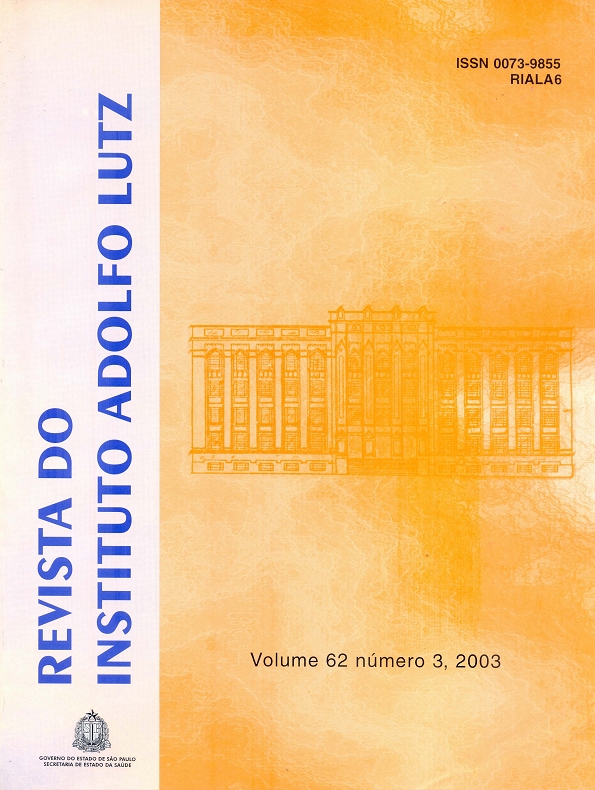Abstract
The objective of this study was to evaluate the contamination of peanut and peanut products
by aflatoxins (B1, B2, G1 e G2) commercialized in Salvador and some cities of the state of Bahia. It was
analysed 100 samples, from which 33 were peanuts and 22 peanuts products. The samples were randomly
collected in different groceries in Salvador (75) and from 14 different cities of the state of Bahia (25) from
January to October 2002. The extraction of the samples was realized with acetonitrile:water (84:16, v/v),
and quantification of the aflatoxins was made using the HPLC method with fluorescence detection.From
the 33 samples of peanuts analysed, 31 (93,9%) were positive, and from these, 19 (57,58%) exhibited
contamination by aflatoxins (B1+B2+ G1+G2) higher or equal to 20µg/kg. From the 67 samples of peanut
products, only 4 (5,98%) presented contamination by aflatoxins (B1+B2+ G1+G2) higher or equal to 20µg/
kg. According to the results, 20 (80%) of the whole samples (25) collected at the cities of the state of Bahia
and 38 (50,7) of the 75 samples collected in Salvador were positive. The results indicate the great importance
of a effective control of aflatoxin levels in these products.
References
1. Anuário Estatístico da Bahia, SEI – Informação a Serviço da Sociedade. Salvador, Bahia, 13:1-570, 1999.
2. Bautista, A.R.P.L. et al. Aflatoxinas em grãos de milho armazenado no Estado da Bahia. Rev. Soc. Bras. Toxicol., 2(1): 24-25, 1989.
3. Brigido, B.M.; Badolato, M.I.C.; Freitas, V.P.S. Contaminação de amendoim e seus produtos comercializados na região de Campinas/SP, por aflatoxinas durante o ano de 1994. Rev. Inst. Adolfo Lutz, 55(2): 85-90, 1995.
4. Caldas, E.D.; Silva, S.C.; Oliveira, J.N. Aflatoxinas e ocratoxina A em alimentos e riscos para a saúde humana. Rev. Saúde Pública, v. 36, n.3, p. 319-323, 2002.
5. CAST (Council for Agricultural Science and Technology). Mycotoxins: Risks in plants, animal and human systems. Cap. 3,Task Force Report, January, n. 139, Ames:Iowa:USA, 2003. 199p.
6. Colaço, W.; Ferraz, U.; Albuquerque, R.L. Incidência de aflatoxina em amendoim e produtos derivados consumidos na cidade de Recife no período de 1989 a 1991. Rev. Inst. Adolfo Lutz, 54(1): 1-4, 1994.
7. Harris, C.C. Deichmann Lecture – p53 tumor suppressor gene at the crossroad of molecular carcinogenesis, molecular epidemiology and cancer risk assessment. Toxicology Letters, v. 82, n. 83, p.1-7, 1995.
8. Hussein, H.S.; Brase, J.M. Toxicity, metabolism and impact of mycotoxins on humans and animals. Toxicology, n. 167, p.101-134, 2001.
9. IARC – Monographs on the Evolution Carcinogenic Risk to Human. Lyon, IARC – International Agency for Research on Cancer, Volume 56, 1993, p. 245-395.
10. Mallmann, C.A. et al., Automation of the analytical procedure for the simultaneous determination of aflatoxins AFB1, AFB2, AFG1 And AFG2. In X International IUPAC Symposium on Mycotoxins and Phycotoxins 2000. Guarujá, São Paulo- Brasil. 21-25 may, p.35.
11. Ministério da Saúde: Resolução RDC no 274, da ANVISA, de 15 de outubro de 2002, publicada no Diário Oficial da União, de 16/10/2002.
12. Oliveira, V. et al. Ocorrência de Aflatoxinas B1 e G1 em amendoim comercializado em Goiânia/GO, Brasil. Rev. Microbiol., São Paulo, 22(4): 319-22, 1991.
13. OMS (Organizacion Mundial de la Salud). Critérios de salud ambiental 11: Micotoxinas, 1983. 131p.
14. Prado, G. et al. Efeito da umidade relativa na contaminação microbiana e produção de aflatoxinas em amendoim em grão. Ciênc. Tecnol. Alim., 11:264-273, 1991.
15. Sabino, M. et al. Occurrence of aflatoxins in peanuts and peanut products consumed in the State of São Paulo/Brazil from 1995 to 1997. Rev. Microbiol.30: 85-88, 1999.
16. Sabino, M.; Rodriguez-Amaya, D.B. Mycotoxins research in Brazil. Rev. Ciência e Cultura (Journal of Brazilian Association for Advancement of Science), 45 (6): 359-71, 1993.
17. Santos, C.C.M. dos; Lopes, M. do R.V. e Kosseki, S.Y. Ocorrência de aflatoxinas em amendoim e produtos de amendoim comercializados na região de São José do Rio Preto/SP. Rev. Inst. Adolfo Lutz, 60(2): 153-157, 2001.
18. Silva, J.C.; Oliveira, J.N.; Caldas, E.D. Aflatoxinas em alimentos comercializados no Distrito Federal de 1985 a 1995. Rev. Inst. Adolfo Lutz, 56(2): 49-52, 1996.
19. Smith, J.E. et al. Storage product ecology and mycotoxin formation. Mycotoxins and Phycotoxins – Development in Chemistry, Toxicology and Food safety, 1998, p.289-302. Editora Alaken, Inc.: Fort Collins, Colorado. 608p.
20. World Health Organization – Mycotoxins – In: Environmental Health Criteria 11, Geneve, WHO, 1979. p.127.

This work is licensed under a Creative Commons Attribution 4.0 International License.
Copyright (c) 2003 Revista do Instituto Adolfo Lutz
